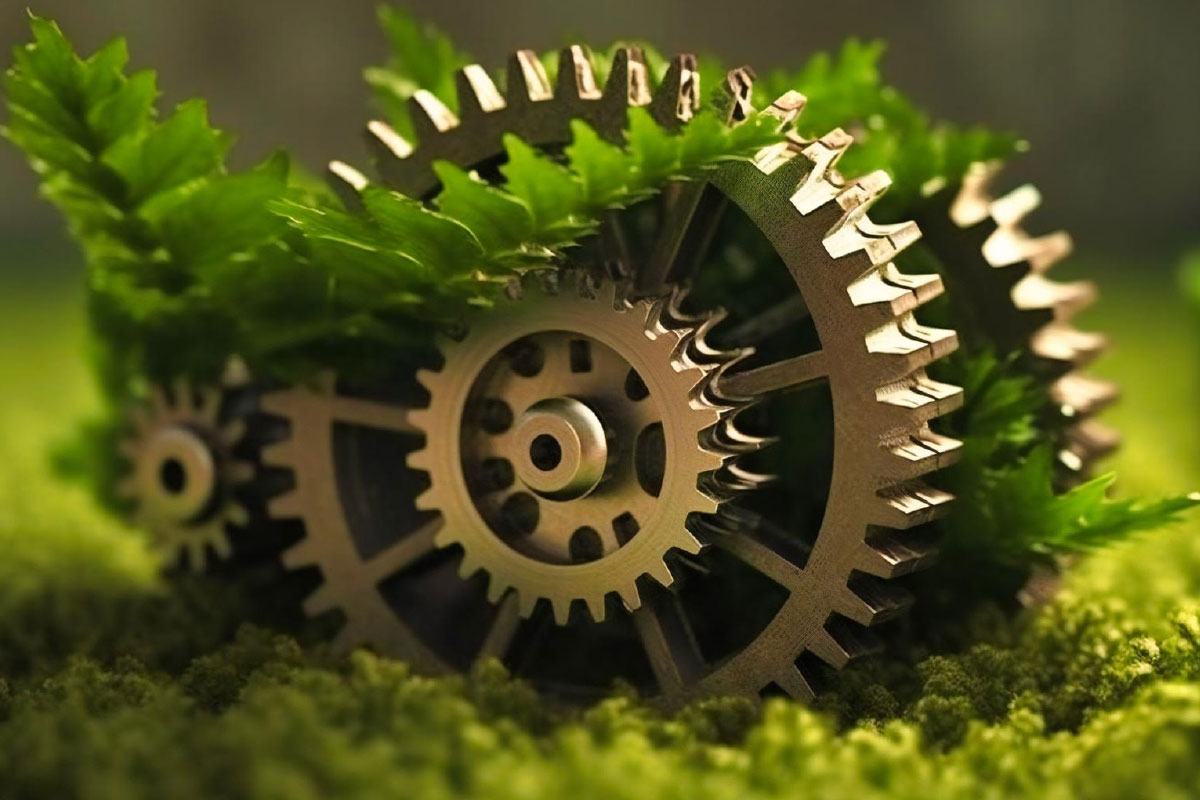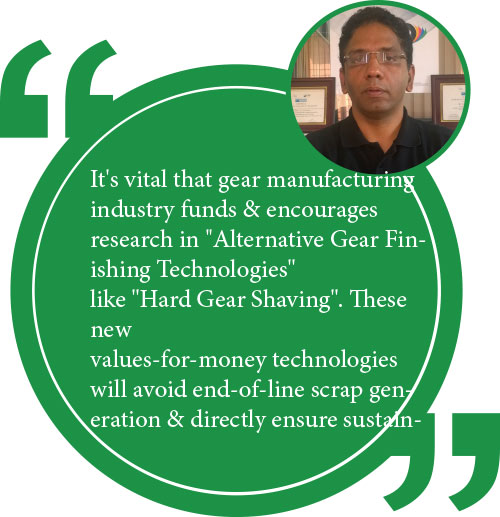
By: Sushmita Das
It is essential for gear manufacturers to be socially accountable throughout the process of manufacturing gear.
This can be done by curbing the looming menace of industrial waste in the environment. This calls for responsible gear manufacturers to carry out a regular environmental assessment for a sustainable future.
According to the Brundtland Report-1987 of the United Nations World Commission on Environment and Development, the term sustainability can be defined as the “development that meets the needs of the present without compromising the ability of future generations to meet their own needs.”
Maintaining sustainability in the gear manufacturing industry is challenging for the engineering team involved in the process. There are various reasons that contribute to environmental pollution, therefore mitigating them can lead the gear industry towards sustainable manufacturing. The rising environmental concerns have necessitated the manufacturing industries to venture through all the possible sustainable methods of developing gears.
The article explores the best possible ways through which industries can rely upon sustainable techniques of manufacturing gears to avoid unprecedented environmental hazards.
Additionally, one becomes aware of the harmful impacts of the gear manufacturing processes on the environment, and the subsequent advancement in the gear industries that includes sustainable gear designs.
Let’s dive into learning the sustainable methods of gear manufacturing.
Exploring sustainable practices in machine tool manufacturing can significantly contribute to reducing the industry’s carbon footprint and fostering innovation.
The following are a few inspiring examples of sustainability in the machine tool manufacturing within the gear industry.

The gear industry is embracing energy-efficient manufacturing techniques by using advanced CNC machines and lean manufacturing practices.
These methods optimize resource utilization, reduce energy consumption, and minimize waste production during production.
Precision engineering ensures gears are manufactured with high accuracy, reducing the chances of premature wear and tear.
This results in longer-lasting gears, leading to less frequent replacements and a reduction in overall material consumption.
Research into sustainable materials for gear manufacturing such as high-strength composites and recyclable alloys is gaining traction. These materials offer improved durability and reduced environmental impact compared to traditional options.
Developing eco-friendly lubricants with longer lifespans not only enhances gear performance but also decreases the frequency of maintenance, lowering the consumption of lubricants and reducing waste.
Closed-loop manufacturing systems monitor and optimize processes in real time, minimizing errors and scrap production.
This approach not only enhances the quality of gears but also conserves resources and energy.
Digital twin technology creates virtual replicas of physical gears, enabling manufacturers to simulate performance under various conditions. This reduces the need for physical prototypes and iterations, saving resources and cutting down on waste. Take alternate pic used for digital twin for earlier article
Efficient supply chain management reduces the carbon footprint by optimizing transportation routes, minimizing material waste, and streamlining logistics operations.
The gear industry is increasingly adopting practices such as remanufacturing and recycling, allowing worn-out gears to be refurbished and repurposed rather than discarded. This extends the lifecycle of products and reduces the demand for new resources.
Machine tool manufacturing processes are integrating renewable energy sources, such as solar panels and wind turbines, to power production facilities. This transition to clean energy reduces the carbon emissions associated with manufacturing.
Industry collaborations and partnerships are promoting knowledge sharing and research into sustainable practices. These initiatives foster innovation, as experts from various fields work together to develop more eco-friendly manufacturing methods.
Powder metallurgy has long been a favored technique for producing intricate components with high precision. In gear manufacturing, Powder Metal (PM) technology involves compressing fine metal powders into the desired shape and then sintering them at high temperatures to form solid parts.
Modified PM Gears take this process a step further by introducing innovations in design and material composition, resulting in a new generation of sustainable gear solutions.
Resource Efficiency: The Powder Metal process allows for near-net shape production, minimizing material wastage and reducing the need for extensive machining. This resource-efficient method aligns with sustainable manufacturing principles.
Weight Reduction: Modified PM Gears can be designed to have complex internal geometries, allowing for intricate designs that optimize strength-to-weight ratios.
This feature is particularly crucial in industries like automotive and aerospace, where weight reduction directly translates to fuel efficiency and reduced emissions.
Enhanced Durability: Through careful material selection and precision engineering, Modified PM Gears offer exceptional durability, reducing the frequency of replacements and extending the life cycle of machinery.
Reduced Carbon Footprint: The efficient production process of Modified PM Gears requires less energy compared to traditional manufacturing methods, contributing to a lower carbon footprint.
Additionally, the extended lifespan of these gears leads to a reduction in waste generation.
Customization and Innovation: The Powder Metal process allows for intricate designs and customization, enabling engineers to create gears tailored to specific applications. This flexibility drives innovation and promotes efficient gear usage.
Complex Geometries: The Powder Metal process facilitates the creation of complex gear geometries that optimize load distribution and enhance performance, all while maintaining the required precision.

Material Composition: Engineers can modify the material composition of PM gears to enhance properties such as wear resistance, corrosion resistance, and strength, ensuring that gears are
well-suited to the demands of their applications.
Noise Reduction: By strategically designing gear profiles and tooth shapes, Modified PM Gears can reduce noise during operation, contributing to a quieter and more sustainable working environment.
Heat Treatment and Surface Coatings: These gears can undergo heat treatment and receive surface coatings to further enhance their performance characteristics, resulting in gears that are both resilient and efficient.
The design of Modified Powder Metal (PM) Gears signifies a significant leap forward in sustainable gear manufacturing.
Conclusion
In an era where environmental concerns and resource conservation are paramount, industries across the globe are redefining their operations to prioritize sustainability.
The gear manufacturing industry, a cornerstone of modern engineering and production processes, is no exception. As the heart of various mechanical systems, gears play a vital role in industries ranging from automotive to aerospace.
Through these efforts, the industry is not only reducing its environmental impacts but also, setting a precedent for other manufacturing sectors to follow.
By keeping the gear industry at the center of the sustainability discussion, we can pave the way for a more environmentally-conscious and innovative future.

Sushmita Das is an accomplished technical writer. Holding a degree in Electrical Instrumentation and Control System Engineering, she brings a wealth of technical expertise to her writingC